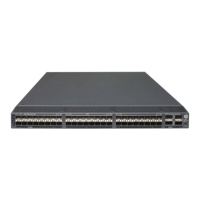17
Tasks at a
lance
Configuring basic CFD settings:
• (Required.) Enabling CFD
• (Required.) Configuring service instances
• (Required.) Configuring MEPs
• (Required.) Configuring MIP auto-generation rules
Configuring CFD functions:
• (Required.) Configuring CC on MEPs
• (Optional.) Configuring LB on MEPs
• (Optional.) Configuring LT on MEPs
Typically, a port blocked by the spanning tree feature cannot receive or send CFD messages except in the
following cases:
• The port is configured as an outward-facing MEP.
• The port is configured as a MIP or inward-facing MEP, which can still receive and send CFD
messages except CCM messages.
For more information about the spanning tree feature, see Layer 2—LAN Switching Configuration Guide.
Configuring basic CFD settings
Enabling CFD
Ste
Command
Remarks
1. Enter system view.
system-view N/A
2. Enable CFD.
cfd enable By default, CFD is disabled.
Configuring service instances
Before configuring the MEPs and MIPs, you must first configure service instances. A service instance is a
set of service access points (SAPs), and belongs to an MA in an MD.
The MD and MA define the level attribute and VLAN attribute of the messages handled by the MPs in a
service instance. The MPs of the MA that has no VLAN attribute do not belong to any VLAN.
To configure a service instance with the MD name:
Ste
Command
Remarks
1. Enter system view.
system-view N/A
2. Create an MD.
cfd md md-name [ index
index-value ] level level-value
By default, no MD is created.

